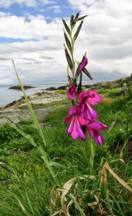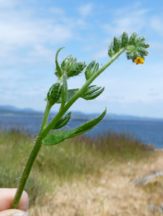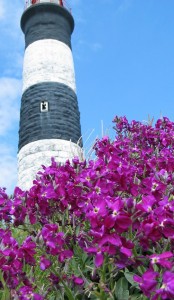 Throughout the year, on the main island of Great Race Rocks, a changing array of introduced garden flowers range over the landscape of the island. This island had been used by the British Colonial Navy and then by the Canadian Coast Guard since the 1860’s . During that time, many light keepers and their assistants had brought ashore soil and had planted gardens for their own provisioning. Along with the soil came many introduced species, and over the years, those species of plants that have been tolerant of the salt spray and the extreme drought of the summer months have survived. A further selective force was the “trimming and mowing” of the grass and the rock knolls on the island. Fire was always a hazard and as a result every attempt was made to prevent the build up of organic materials. In 1997 when Lester Pearson College started managing the environment on the island, a decision was made to attempt to restore the grassed area to a more natural environment by leaving it in its natural state. The introduced flowers are not cultivated, if they survived the conditions, they are allowed to flourish. Those that are unpalatable to Canada geese grazing now have an advantage. The unique thing about these perennials is that they often remain flowering throughout the winter since the air temperature, moderated by the surrounding waters keeps it the above freezing.
Throughout the year, on the main island of Great Race Rocks, a changing array of introduced garden flowers range over the landscape of the island. This island had been used by the British Colonial Navy and then by the Canadian Coast Guard since the 1860’s . During that time, many light keepers and their assistants had brought ashore soil and had planted gardens for their own provisioning. Along with the soil came many introduced species, and over the years, those species of plants that have been tolerant of the salt spray and the extreme drought of the summer months have survived. A further selective force was the “trimming and mowing” of the grass and the rock knolls on the island. Fire was always a hazard and as a result every attempt was made to prevent the build up of organic materials. In 1997 when Lester Pearson College started managing the environment on the island, a decision was made to attempt to restore the grassed area to a more natural environment by leaving it in its natural state. The introduced flowers are not cultivated, if they survived the conditions, they are allowed to flourish. Those that are unpalatable to Canada geese grazing now have an advantage. The unique thing about these perennials is that they often remain flowering throughout the winter since the air temperature, moderated by the surrounding waters keeps it the above freezing.
Link to other Posts on the Terrestrial Plants of Race Rocks
 |
 |
 |
 |
| Hyacinthoides non-scripta: English bluebells. Native to Europe. |
Matthiola incana: evening-scented stock, first discovered growing on cliffs above the sea in England. Also in picture with tower, above right. |
Muscari racemosum / neglectum: Grape Hyacinth: native to Armenia |
Crocus vernus subsp. vernus: Native to Asia. |
 |
 |
 |
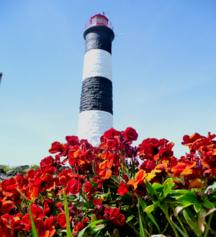 |
| Sedum sp.: possibly Sedum album see also below This was introduced beside the assistant keepers house in the mid 1980s and has since spread over most of the rock-exposed parts of the island, partially because of increased pressure of Canada goose grazing on other plants |
Calendula sp.: Native to the area from Macaronesia east through the Mediterranean region to Iran. Also shown beside the paths below where it self-seeds each year. |
Cheiranthus allionii: Perennial wall flower, native to the Canary islands. This plant will flower throughout the year.In mild winters it does not stop blooming. |
Cheiranthus allionii .–wallflowers near the residence with the tower in the background |
 |
 |
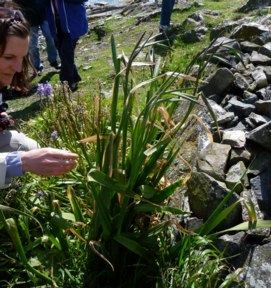 |
|
| Sedum sp. |
Pathway at Race Rocks with naturally growing border of Calendula.(Gulls will occasionally rip some out for nesting material.) |
Gladiolus imbricatus : It is not yet in bloom in this picture, but several clumps grow in late May on the east side of the main residence. |
G.imbricatusin bloom: Originally from south-eastern Europe/Turkey, it has been growing unattended here for over 50 years. |
 |
|
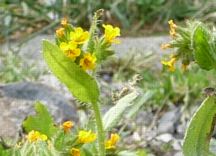 |
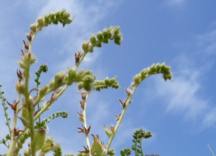 |
| This fiddleneck,Amsinckia spectabilis is a recent arrival to the islands, |
Amsinckia spectabilis in bloom. Although not a garden escape, it has colonized many areas here possibly because of the unpalatability to Canada geese. |
Close up of Amsinckia spectabilis in bloom.. |
Fiddle shaped seed heads of Amsinckia spectabilis. Below are the seeds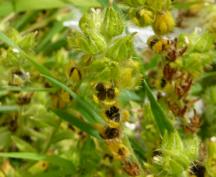 Unless otherwise stated, photos on this page were taken by G. Fletcher Unless otherwise stated, photos on this page were taken by G. Fletcher |
 Throughout the year, on the main island of Great Race Rocks, a changing array of introduced garden flowers range over the landscape of the island. This island had been used by the British Colonial Navy and then by the Canadian Coast Guard since the 1860’s . During that time, many light keepers and their assistants had brought ashore soil and had planted gardens for their own provisioning. Along with the soil came many introduced species, and over the years, those species of plants that have been tolerant of the salt spray and the extreme drought of the summer months have survived. A further selective force was the “trimming and mowing” of the grass and the rock knolls on the island. Fire was always a hazard and as a result every attempt was made to prevent the build up of organic materials. In 1997 when Lester Pearson College started managing the environment on the island, a decision was made to attempt to restore the grassed area to a more natural environment by leaving it in its natural state. The introduced flowers are not cultivated, if they survived the conditions, they are allowed to flourish. Those that are unpalatable to Canada geese grazing now have an advantage. The unique thing about these perennials is that they often remain flowering throughout the winter since the air temperature, moderated by the surrounding waters keeps it the above freezing.
Throughout the year, on the main island of Great Race Rocks, a changing array of introduced garden flowers range over the landscape of the island. This island had been used by the British Colonial Navy and then by the Canadian Coast Guard since the 1860’s . During that time, many light keepers and their assistants had brought ashore soil and had planted gardens for their own provisioning. Along with the soil came many introduced species, and over the years, those species of plants that have been tolerant of the salt spray and the extreme drought of the summer months have survived. A further selective force was the “trimming and mowing” of the grass and the rock knolls on the island. Fire was always a hazard and as a result every attempt was made to prevent the build up of organic materials. In 1997 when Lester Pearson College started managing the environment on the island, a decision was made to attempt to restore the grassed area to a more natural environment by leaving it in its natural state. The introduced flowers are not cultivated, if they survived the conditions, they are allowed to flourish. Those that are unpalatable to Canada geese grazing now have an advantage. The unique thing about these perennials is that they often remain flowering throughout the winter since the air temperature, moderated by the surrounding waters keeps it the above freezing.










